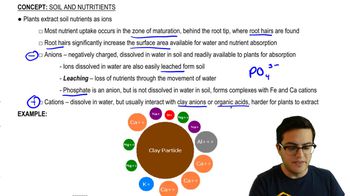Table of contents
- 1. Introduction to Biology2h 42m
- 2. Chemistry3h 40m
- 3. Water1h 26m
- 4. Biomolecules2h 23m
- 5. Cell Components2h 26m
- 6. The Membrane2h 31m
- 7. Energy and Metabolism2h 0m
- 8. Respiration2h 40m
- 9. Photosynthesis2h 49m
- 10. Cell Signaling59m
- 11. Cell Division2h 47m
- 12. Meiosis2h 0m
- 13. Mendelian Genetics4h 44m
- Introduction to Mendel's Experiments7m
- Genotype vs. Phenotype17m
- Punnett Squares13m
- Mendel's Experiments26m
- Mendel's Laws18m
- Monohybrid Crosses19m
- Test Crosses14m
- Dihybrid Crosses20m
- Punnett Square Probability26m
- Incomplete Dominance vs. Codominance20m
- Epistasis7m
- Non-Mendelian Genetics12m
- Pedigrees6m
- Autosomal Inheritance21m
- Sex-Linked Inheritance43m
- X-Inactivation9m
- 14. DNA Synthesis2h 27m
- 15. Gene Expression3h 20m
- 16. Regulation of Expression3h 31m
- Introduction to Regulation of Gene Expression13m
- Prokaryotic Gene Regulation via Operons27m
- The Lac Operon21m
- Glucose's Impact on Lac Operon25m
- The Trp Operon20m
- Review of the Lac Operon & Trp Operon11m
- Introduction to Eukaryotic Gene Regulation9m
- Eukaryotic Chromatin Modifications16m
- Eukaryotic Transcriptional Control22m
- Eukaryotic Post-Transcriptional Regulation28m
- Eukaryotic Post-Translational Regulation13m
- 17. Viruses37m
- 18. Biotechnology2h 58m
- 19. Genomics17m
- 20. Development1h 5m
- 21. Evolution3h 1m
- 22. Evolution of Populations3h 52m
- 23. Speciation1h 37m
- 24. History of Life on Earth2h 6m
- 25. Phylogeny2h 31m
- 26. Prokaryotes4h 59m
- 27. Protists1h 12m
- 28. Plants1h 22m
- 29. Fungi36m
- 30. Overview of Animals34m
- 31. Invertebrates1h 2m
- 32. Vertebrates50m
- 33. Plant Anatomy1h 3m
- 34. Vascular Plant Transport1h 2m
- 35. Soil37m
- 36. Plant Reproduction47m
- 37. Plant Sensation and Response1h 9m
- 38. Animal Form and Function1h 19m
- 39. Digestive System1h 10m
- 40. Circulatory System1h 57m
- 41. Immune System1h 12m
- 42. Osmoregulation and Excretion50m
- 43. Endocrine System1h 4m
- 44. Animal Reproduction1h 2m
- 45. Nervous System1h 55m
- 46. Sensory Systems46m
- 47. Muscle Systems23m
- 48. Ecology3h 11m
- Introduction to Ecology20m
- Biogeography14m
- Earth's Climate Patterns50m
- Introduction to Terrestrial Biomes10m
- Terrestrial Biomes: Near Equator13m
- Terrestrial Biomes: Temperate Regions10m
- Terrestrial Biomes: Northern Regions15m
- Introduction to Aquatic Biomes27m
- Freshwater Aquatic Biomes14m
- Marine Aquatic Biomes13m
- 49. Animal Behavior28m
- 50. Population Ecology3h 41m
- Introduction to Population Ecology28m
- Population Sampling Methods23m
- Life History12m
- Population Demography17m
- Factors Limiting Population Growth14m
- Introduction to Population Growth Models22m
- Linear Population Growth6m
- Exponential Population Growth29m
- Logistic Population Growth32m
- r/K Selection10m
- The Human Population22m
- 51. Community Ecology2h 46m
- Introduction to Community Ecology2m
- Introduction to Community Interactions9m
- Community Interactions: Competition (-/-)38m
- Community Interactions: Exploitation (+/-)23m
- Community Interactions: Mutualism (+/+) & Commensalism (+/0)9m
- Community Structure35m
- Community Dynamics26m
- Geographic Impact on Communities21m
- 52. Ecosystems2h 36m
- 53. Conservation Biology24m
35. Soil
Soil and Nutrients
Problem 5`
Textbook Question
A problem with intensive irrigation is
a. Overfertilization.
b. Aquifer depletion.
c. The long-term depletion of soil oxygen.
d. The clogging of waterways by vegetation debris.
 Verified step by step guidance
Verified step by step guidance1
Understand the context of intensive irrigation: Intensive irrigation involves the application of large amounts of water to crops, often to maximize agricultural yield.
Consider the potential environmental impacts of intensive irrigation: This practice can lead to various environmental issues, such as waterlogging, salinization, and depletion of water resources.
Analyze each option: (A) Overfertilization is related to the excessive use of fertilizers, not directly to irrigation. (B) Aquifer depletion occurs when groundwater is extracted faster than it is replenished, which can be exacerbated by intensive irrigation. (C) Long-term depletion of soil oxygen is more related to waterlogging, which can occur with excessive irrigation. (D) Clogging of waterways by vegetation debris is not a direct consequence of irrigation.
Focus on aquifer depletion: Intensive irrigation often relies on groundwater sources, leading to the depletion of aquifers as water is extracted at unsustainable rates.
Conclude that aquifer depletion is a significant problem associated with intensive irrigation, as it directly relates to the overuse of water resources.
 Verified video answer for a similar problem:
Verified video answer for a similar problem:This video solution was recommended by our tutors as helpful for the problem above
Video duration:
1mPlay a video:
Was this helpful?
Key Concepts
Here are the essential concepts you must grasp in order to answer the question correctly.
Aquifer Depletion
Aquifer depletion occurs when water is extracted from underground aquifers faster than it is replenished. This is a common issue with intensive irrigation, as large volumes of water are needed to sustain crops, leading to a significant drop in groundwater levels. Over time, this can result in reduced water availability for future agricultural and personal use.
Recommended video:
Guided course

Water Cycle
Soil Oxygen Depletion
Soil oxygen depletion refers to the reduction of oxygen levels in the soil, which can occur due to excessive water saturation from intensive irrigation. When soil is overly saturated, it limits the air spaces within the soil, reducing oxygen availability for plant roots and soil organisms, potentially leading to poor plant growth and soil health.
Recommended video:
Guided course

Soil Composition
Waterway Clogging by Vegetation Debris
Clogging of waterways by vegetation debris can happen when irrigation systems wash plant material into nearby streams and rivers. This debris can accumulate, obstructing water flow and affecting aquatic ecosystems. Proper management and filtration systems are necessary to prevent such blockages and maintain healthy waterways.
Recommended video:
Guided course

Lysosomes & Peroxisomes
Related Videos
Related Practice





















